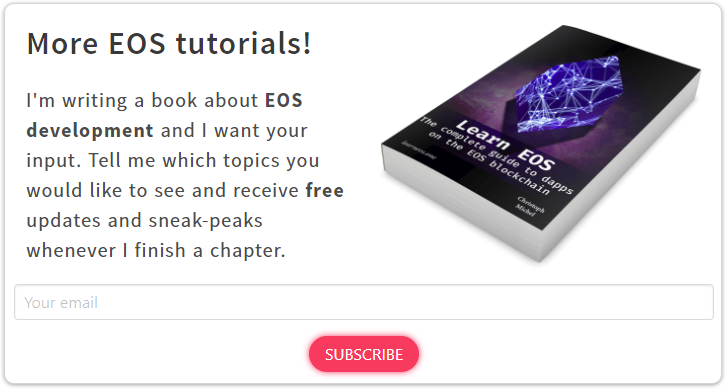C++ Guide for EOS Development - Multi-Index Container
This post is part of my C++ Guide for EOS developers
- Basics
- Call by value / reference & Pointers
- Classes and Structs
- Templates
- Iterators & Lambda Expressions
- Multi-index
- Header files
Multi-index
The last important topic we will cover is multi-indexes.
The standard library comes with many containers like vectors (dynamic array), lists (doubly-linked list), sets or maps.
While all serve the same purpose of storing and accessing elements, each of them achieves this differently leading to different runtimes of fundamental operations - a set, for instance, maintains its elements in a sorted way, whereas a list does not yield random access but allows you to insert elements at any place in constant time without reallocating.
They all provide a single specific way to access your elements, but sometimes we want to have multiple interfaces to the same data.
Let’s look at a CryptoCurrency class:
#include <iostream>
#include <set>
#include <string>
#include <algorithm>
using namespace std;
class CryptoCurrency {
public:
string name;
uint64_t market_cap;
double priceInUSD;
CryptoCurrency(const string &name, uint64_t market_cap, double priceInUSD) : name(name), market_cap(market_cap), priceInUSD(priceInUSD) {}
// define comparison < operator to compare cryptos by market_cap
bool operator<(const CryptoCurrency& c) const {
return market_cap < c.market_cap;
}
};
int main()
{
// store some crypto currencies in a set
set<CryptoCurrency> cryptos;
cryptos.insert(CryptoCurrency("EOS", 1000, 1.0));
cryptos.insert(CryptoCurrency("Bitcoin", 2000, 10.0));
cryptos.insert(CryptoCurrency("Ethereum", 500, 2.0));
// sets order their elements, in our case according to market_cap
// iterating the currencies in ascending order
for_each(cryptos.begin(), cryptos.end(), [](const CryptoCurrency& c) {
cout << c.name << " " << c.market_cap << "\n";
});
}A set is a nice way to keep the crypto-currencies ordered by a single index, in our case market_cap.
But what happens if you need an alphabetically ordered-list of the currencies?
An approach would be to keep a set of pointers to the set elements ordered by the name field this time.
However, there’s an easier approach: What we need is a way to define multiple indexes to the same data elements.
This is exactly the concept of multi_index_containers from the boost library.
The Boost library is an external library which is highly-used in practice because it solves a wide range of common tasks not in the C++ standard library, comes with nice documentation and tutorials, and is open-source and peer-reviewed. (You can also use it when writing your smart contracts!)
"The obvious solution for most programmers is to use a library that provides an elegant and efficient platform independent to needed services. Examples are BOOST..." — Bjarne StroustrupLet’s take a look how to make our class work with multi_index_containers:
#include <iostream>
#include <set>
#include <string>
#include <algorithm>
#include <boost/multi_index_container.hpp>
#include <boost/multi_index/ordered_index.hpp>
#include <boost/multi_index/identity.hpp>
#include <boost/multi_index/member.hpp>
using namespace std;
using namespace boost; // for multi_index_container
// for indexed_by, ordered_unique, member, identity
using namespace boost::multi_index;
class CryptoCurrency
{
public:
string name;
uint64_t market_cap;
double priceInUSD;
CryptoCurrency(const string &name, uint64_t market_cap, double priceInUSD) : name(name), market_cap(market_cap), priceInUSD(priceInUSD) {}
// define comparison < operator to compare cryptos by market_cap
bool operator<(const CryptoCurrency &c) const
{
return market_cap < c.market_cap;
}
};
// typedef is a way to alias types
// multi_index_container<...> will be aliased as crypto_set
typedef multi_index_container
<
CryptoCurrency,
indexed_by
<
// sort by CryptoCurrency::operator<
ordered_unique<identity<CryptoCurrency>>,
// sort by string's < on CryptoCurrency::name member
ordered_unique<member<CryptoCurrency, std::string, &CryptoCurrency::name>>
>
> crypto_set;
int main()
{
// use the typedef'd multi_index_container
crypto_set cryptos;
cryptos.insert(CryptoCurrency("Eos", 1000, 1.0));
cryptos.insert(CryptoCurrency("Bitcoin", 2000, 10.0));
cryptos.insert(CryptoCurrency("Ethereum", 500, 2.0));
// interface through the first index by market_cap
// market_cap_index is now an iterator having .begin() and .end()
// make sure to not forget the '&' after ::type or use auto
const crypto_set::nth_index<0>::type &market_cap_index = cryptos.get<0>();
for_each(market_cap_index.begin(), market_cap_index.end(), [](const CryptoCurrency &c) {
cout << c.name << " " << c.market_cap << "\n";
});
// alternatively you can omit the .get<0>().begin() and call .begin() directly
// not providing .get<index> always returns the first index
// so we don't even need to change the old code for sorting by market_cap!
for_each(cryptos.begin(), cryptos.end(), [](const CryptoCurrency &c) {
cout << c.name << " " << c.market_cap << "\n";
});
// now interface through the _second_ index by name
// const crypto_set::nth_index<1>::type& name_index = cryptos.get<1>();
const auto &name_index = cryptos.get<1>();
for_each(name_index.begin(), name_index.end(), [](const CryptoCurrency &c) {
cout << c.name << " " << c.market_cap << "\n";
});
}
There are more index types than ordered_unique or ordered_non_unique (for non-unique class members).
While these two provide an interface similar to storing CryptoCurrency as a std::set, sequenced<> indexes provide a bidirectional interface like std::list.
Sequenced indexes are useful when you want to keep the original order of the time you inserted the elements.
If you need access to a specific position like with a std::vector, there’s a random_access<> index for that.
We will revisit multi_index_containers when we store and retrieve data tables in the EOS blockchain through our smart contract.
As you can imagine, having multiple interfaces to sort and search for elements in your database tables is really useful.
If you want to learn more about them, boost.org has an exhaustive tutorial on it.

